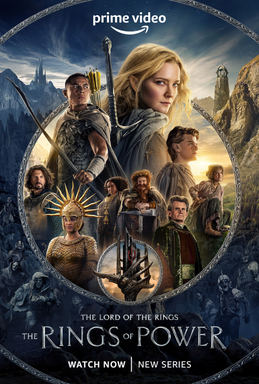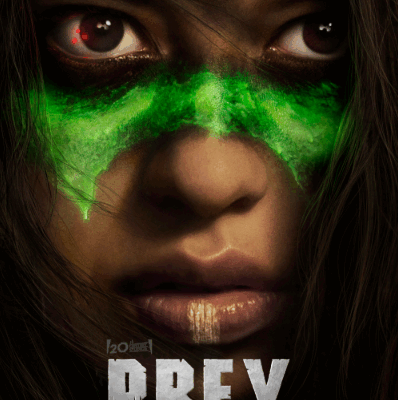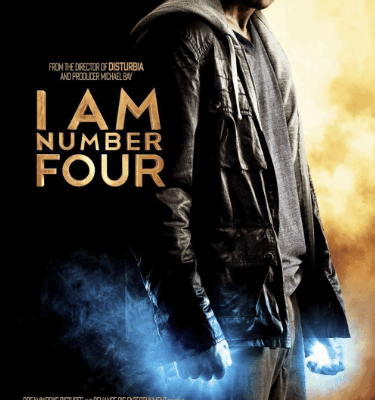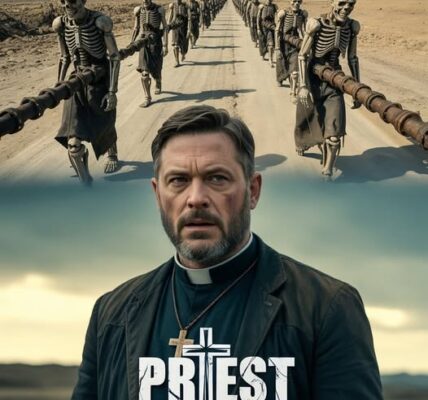Movie/Series Overview
- Title: The Lord of the Rings: The Rings of Power
- Release Date: First Season premiered on September 1, 2022 on Prime Video.
- Genre: Fantasy / Adventure / Drama
- Creators / Developers: Developed by J. D. Payne & Patrick McKay for Amazon Prime Video.
- Main Cast: Among many characters: Morfydd Clark as Galadriel; Robert Aramayo as Elrond; Cynthia Addai-Robinson as Queen-Regent Míriel; Maxim Baldry as Isildur; Charlie Vickers as Halbrand / Sauron; Owain Arthur as Durin IV; etc.
- Where to Watch: Amazon Prime Video globally (in permitted regions).
1. Plot Summary
The Rings of Power is set in the Second Age of Middle-earth, thousands of years before the events of The Hobbit and The Lord of the Rings.
The series follows an ensemble cast of characters across different races and realms: Elves, Dwarves, Harfoots (early form of Hobbits), and Men. Among key figures are Galadriel, driven by vengeance and seeking to confront rising evil; Elrond, a younger elf with wisdom yet to be fully formed; Durin IV, heir in the Dwarven kingdom of Khazad-dûm; Isildur and his family in Númenor; Halbrand, a mysterious human who joins Galadriel on her journey and whose identity becomes central; plus others including The Stranger, Harfoots, and human survivors in the Southlands.
In the first season, several plot strands converge: the reemergence of orc threats in the Southlands; the forging of the first Elven Rings of Power under the guidance of Celebrimbor; political intrigue in Númenor (especially Queen-Regent Míriel and her senatorial politics); the unfolding mystery around Halbrand/“Sauron in disguise”; and the transformation of a once peaceful land (Southlands) into a scorched, ruined territory (which becomes Mordor) after catastrophic events.
Overall, the story is a build-up towards the rise of Sauron, the forging of rings, civilizational decline through pride, betrayal, and unresolved evil — charting how great societies and characters are corrupted or tested.
2. Notable Elements
Here are what I think are the strongest / most distinctive parts of The Rings of Power, and some things that are weaker or controversial.
What Makes It Stand Out
- Scale & Visual Production: The show does an impressive job with visuals, set design, costumes, and landscapes. New Zealand locations (for Season 1) help bring that Middle-earth feel. The costuming, armor, architecture (especially Númenor) are notably grand.
- World-building & Lore Expansion: Because Tolkien’s texts (especially the Appendices) give less narrative detail for the Second Age, the series has freedom to fill in gaps. Strands like the Harfoots, the stranger who falls from sky, or certain political tensions in Númenor are new or expanded narratives. For fans of lore, this yields both intrigue and debate.
- Character Dynamics: Galadriel’s arc (revenge, loss, leadership), Elrond’s struggles, Durin IV’s conflict between Dwarven traditions and external threats, the relationship between Halbrand and Galadriel build tension. Also the moral ambiguity with some characters is more nuanced than pure good vs evil in places. Halbrand’s identity as Sauron being revealed in Season 1 is a strong twist.
- Moments of Spectacle & Dramatic Set-pieces: Eruptions, orc invasions, the forging of the rings, sea voyages, the political intrigue in Númenor; large-scale threats being slowly revealed. These provide impressive visuals and stakes.
Shortcomings / What Doesn’t Always Work
- Pacing & Narrative Density: Because there are many characters, many locations, many plot threads, at times the story feels diffuse. Some arcs progress slowly; some subplot characters don’t get as much development, making it harder to maintain emotional investment in all threads.
- Balancing Innovation vs. Fan Expectations: Some fans of Tolkien have criticized certain liberties or additions — e.g. reimagining or expanding lore in ways not explicitly from Tolkien, or altering timelines, characters, or geography. These can feel jarring depending on how strictly one adheres to Tolkien’s writings.
- Emotional Weight / Depth in Some Arcs: Some characters’ motivations or emotional journeys are less fleshed out. For example, side characters may suffer or face loss, but because of the many POVs, not all get the screen-time needed to make those losses deeply felt.
- Villainy & Mystery Pacing: The reveal of Halbrand as Sauron works, but some have felt that build-up to that reveals is hit-or-miss, with mystery that sometimes lingers too long without payoff, or with clues that feel either too obvious or too subtle.
3. Themes & Messages
Here are some of the recurring themes, and how they resonate (even if not holiday-specific, still broadly meaningful):
- Power, Corruption, and Temptation: A central theme is how power (or the idea of power) corrupts or tempts even well-intentioned characters. Forging rings (that can preserve, extend life, offer influence) is seductive; pride, desires for vengeance, or for reputation lead to moral compromise.
- Legacy, Loss, and Memory: Characters carry past trauma or loss (Galadriel’s loss, the scars of previous wars), and their decisions are shaped by what came before. There is also the tension between building something lasting vs the fear of legacy being destroyed (as in Númenor’s politics).
- Unity vs Division: Elves, Dwarves, Men, Harfoots are different peoples; alliances, trust, or mistrust between them are explored. Political rivalries or hearts hardened by fear or prejudice are contrasted with possibility of cooperation.
- Duty, Sacrifice, Courage: Many characters are called upon to act beyond personal comfort or safety — defending others, enduring hardship, deciding what kind of future they want even as collapse looms.
- Identity & Disguise / Deception: Halbrand’s hidden identity, as well as the general fog of who to trust, who is acting for one motive or another, etc. This theme of appearances vs truth is strong.
These themes echo many universal ideas: standing up in dark times, doing the right thing even when consequences are severe, bonds between different peoples, recognizing the cost of freedom and peace. They’re less about holiday traditions, but they do resonate with values many traditions share: hope, community, sacrifice, remembrance.
4. Personal Impressions
Here are my thoughts — what I particularly liked, and what I wished were better.
What I Liked
- I found the visual spectacle very compelling. The landscapes, architecture, the design of Númenor — all feel epic. The show often treats Middle-earth with care in its look and feel, which helps immersion.
- Galadriel (Morfydd Clark) is a strong strong performance. Her drive, her internal conflicts, her leadership, are among the more interesting arcs. The reveal that Halbrand is Sauron added real dramatic tension (especially in how it reframes earlier scenes).
- The expansion of lore in certain areas feels fresh. The Harfoots storyline gives a more grounded, human (or halfling-like) viewpoint — daily life, struggle, curiosity. It offers contrast to the high-stakes politics among Men, Elves, and Dwarves.
- Some episodes reach genuine emotional impact: losses in the Southlands, sacrifices, the costs of war. The show doesn’t shy away from darkness.
What I Wished Were Better
- Sometimes pacing lags: certain episodes feel like setup without enough payoff, or scenes that seem to stretch out conflict rather than intensify it. For example, some political intrigue in Númenor is fascinating but can feel slow between major events.
- Some characters feel under-utilized. With so many POVs, some arcs feel like they exist only to fill tapestry rather than to make us care deeply.
- Because of the expansions (added or reinterpreted material), there are occasional fan-frustrations: certain lore changes or interpretations feel inconsistent with some readers’ views of Tolkien’s texts. Whether that’s “wrong” or just different is subjective, but it can reduce immersion for purist fans.
- The mystery around The Stranger (or certain subplots) sometimes feels over-stretched — teasing without giving enough clarity or integration until later.
5. Audience Recommendations
Who is likely to especially enjoy this series, and under what mood?
- If you are a fan of high fantasy world-building (e.g. The Lord of the Rings, Game of Thrones, etc.), especially with large budgets, epic scope, and multiple interwoven storylines, this will appeal.
- If you like lore, myth, history within fantasy — it’s enjoyable if you like seeing how stories, legends, political intrigue, ancient civilizations, and the slow rise of evil are built.
- If you enjoy character drama both on the grand scale (kings, elves, realms) and small scale (families, daily life, individual moral decisions) — there are both kinds here.
- Particularly good for viewers who don’t need every detail of Tolkien’s original texts to match exactly; people open to reinterpretation, adaptation, having new stories within the same mythos.
Less good (or more challenging) for:
- Viewers who specifically want very tight adaptation of Tolkien’s texts, very strict adherence to lore. Some deviations or creative liberties may bother you.
- Those who prefer faster, more focused narratives rather than large ensemble casts and many locations and threads.
- If fantasy isn’t your genre, the weight of ancient plots, mythic stakes, political intrigue might feel overwhelming rather than engaging.
6. Conclusion & Star Rating
In summary, The Lord of the Rings: The Rings of Power is a bold, ambitious expansion of Tolkien’s world, filled with beauty, menace, hope, and many characters striving to do right under impossible pressure. It isn’t perfect — the sprawling nature of the narrative, fluctuations in pacing, and lore-interpretation choices sometimes disappoint — but its strengths (visuals, character work, thematic depth) make it a worthy watch for fantasy fans, especially those who enjoy large scope, mythic storytelling, and spectacle.
Final Recommendation: If you like epic fantasy, you’ll get a lot out of this. If you’ve read Tolkien, you’ll appreciate many echoes and references; if you haven’t, it still works as an adventure with stakes, wonder, and darkness. Worth streaming, especially if you enjoy immersive fantasy TV.
Star Rating: ★★★★☆ (4 out of 5 stars)




